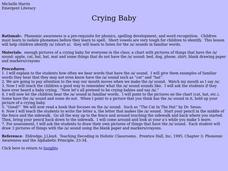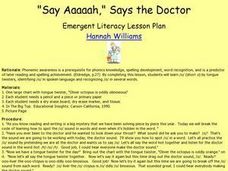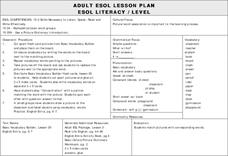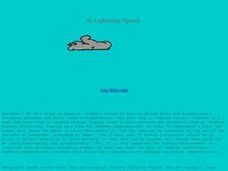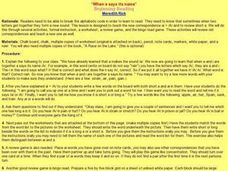Curated OER
Beginning and Ending Sounds
First graders practice the beginning and ending sounds of words. In this phonological awareness lesson plan, 1st graders use picture cards for one syllable words and pronounce each word. Students match other picture cards with the same...
Curated OER
Pictures Associated With the Letters Ee
For this vowel E worksheet, 1st graders view eleven pictures, circle the pictures that begin with an E and then cross out the pictures that do not begin with the letter E.
Curated OER
Beginning, Middle, or End?
Here's a worksheet to help students become familiar with where to find words in a dictionary. Students whether the each of the 15 flower related words would be found at the beginning, middle or end of the dictionary.
Curated OER
Home Spelling Practice Review Unit 5
In this spelling review instructional activity, 1st graders read the four lists of short a and short e words and play a Clues game. Students complete 2 activities.
Curated OER
A? Speak up, I can't hear you!
Students become phonemically aware of various sounds that make up written words. This lesson focuses on the vowel correspondence a_e=/A/. They decode the long a mouth moves in words as well as practice spelling the words themselves.
Curated OER
Nothing but Nests
Students examine both the upper and lower case letter "N,n." They practice making the "n" sound, writing the letter, and recognizing it in words. After a teacher book talk, they listen to Christine Young's, "Nests," and make the "boat...
Curated OER
Say What?
Students explore phonemes in spoken words. They discuss the /e/ (short e) correspondence. Students read "Red Gets Fed." They learn a meaningful letter symbol for the /e/. Students identify /e/ sound in both spoken and written words.
Curated OER
Crying Baby
Students explore phonemes. They discuss the short a sound. Students discuss the shape their mouths make when saying /a/. They read familiar words with the /a/. Students read "The Cat In The Hat." They identify words with the short a sound.
Pennsylvania Department of Education
Writing With Environmental Print
Students develop literacy skills by exploring street signs, cereal boxes, and billboards. In this writing with environmental print lesson, students build word recognition in every day print. Students decode words and discover new words.
Curated OER
Letter Recognition Flash Games for Kids
Students explore the alphabet by completing an on-line letter identification activity. In this phonetics activity, students utilize the website www.literarycenter.net and listen to word sounds as they identify the spelling of the...
Curated OER
Say Aaaaah, Says the Doctor
Pupils explore the short /o/ sound using tongue twisters. They identify the /o/ sound in spoken language and recognize the /o/ in written words. Students practice writing the letter o. They spell words with the /o/ sound and they read In...
Curated OER
ADULT ESOL LESSON PLAN--Skills Necessary to Listen, Speak, Read and Write Effectively
Students practice alphabetizing basic word groups (classroom, playground, etc.) with flash cards and a Picture Dictionary. They realize the importance of communication correctly with others through picture/word association.
Curated OER
Division of Syllables
Study diphthongs in the Spanish language. This resource contains a lot of information, so consider printing one for each learner to reference and walking them through it as a class. There is a short exercise at the bottom of the page to...
Curated OER
At Lightning Speed
Review how to decode words and practice repeated readings for fluency. Kids review the cover-up method as a way to decode unknown words and then practice reading sentences for fluency and short passages with partners. They record their...
Lakeshore Learning
Alphabet Sounds Teaching Tubs
A hands-on activity brings the alphabet to life in your kindergarten! Fill tubs with items that begin with the same letter or end with the same sound, and let kids make the connections between the items.
English To Go
Articles: A, An, The, or -
Help your young native English speakers discern between a, an, or the with this two-page document. Each article is explained before short practice assessments are offered. A short paragraph on the second page also explains what is known...
Curated OER
Double Jeopardy-Homophones
Second graders identify homophones as words that sound alike but have different meanings. They, given a pair of homophones, are to explain the meanings of the words using gestures, role playing, or drawing a picture with their partner.
Curated OER
Sorting words (four-block)
Third graders each receive an index card with a word written on it. They look for spelling patterns such as "oi." Students sort the cards according to spelling pattern, and practice spelling words with the snap, clap, slap hand motions.
Curated OER
When A Says Its Name
Students are introduced to the concept of vowel digraphs. They identify the digraph /ai/ in spoken language. After a brief discussion, students apply the rule for reading and spelling words containing the /ai/ digraph by playing word bingo.
Curated OER
Vowel Change of Short E
In this language arts worksheet, students look for the pattern for changing the vowel "E" into the right form for writing the words in the Latin language.
Pennsylvania Department of Education
What's My Sound?
Students follow a power point presentation to practice the sounds each letter of the alphabet make. In this 'what's my sound' activity, students apply word recognition strategies and demonstrate listening and comprehension skills to...
Curated OER
Spelling-Long E Words
In this spelling worksheet, students copy a set of 6 long e spelling words. Parents are given suggestions to help students study and learn the words.
Curated OER
Here's and Instant Activity for October 20, 2008
Students complete spelling activities for words with or and ore spellings. In this spelling lesson, students find antonyms for the 'or' words in the first exercise. Students find synonyms for the second exercise.
Curated OER
Punch in the Stomach...uhhh
Students discover that letters and their correspondences will lead to successful decoding, reading fluency, and reading comprehension. They recognize the letter u and the correspondence u=/u/. They repeat the tongue twister with the...









